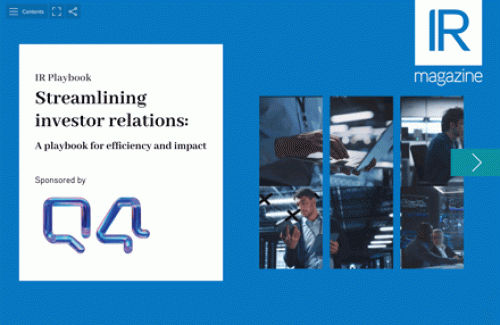‘The reality is that the role of IR is evolving and the need for efficiency is there in order to free up that time to be strategic,’ said Darrell Heaps, founder and CEO of Q4, on a recent IR Magazine Webinar. ‘I think that in a world that doesn’t exist, people are fine with doing things the way they have always done them, but the key question to ask is whether it’s taking valuable time away from being strategic and delivering value.’
Click here to watch a recap of the webinar.
Heaps was one of the panelists at the webinar, in partnership with Q4, that looked at how IROs can consolidate their tech stack to streamline their workflows and leverage AI to reduce the burden of administrative tasks to focus on strategy.
He shared the panel with Kam Mangat, VP of IR and corporate strategy at Nexe Innovations, and Felix Veksler, senior director of IR at Nasdaq-listed automotive service company Monro. Here are some of the key takeaways from the session.
Use AI to make time for what matters
Drawing from his experience at Q4 when it was a public company, Heaps said it became clear how much time IROs traditionally spend on mundane and administrative tasks.
While the administrative component of the IR role doesn’t add strategic value, Heaps said it’s essential and comes with high risk.
‘For example, organizing an earnings call isn’t strategic, so [you might say] we don’t have to worry about it, but that’s at your peril because if the earnings call doesn’t go well, it can become a strategic issue,’ he noted. ‘The interesting thing is that the administrative stuff can’t be de-prioritized, because while it [can have] high consequences, it does get in the way of being able to focus on the right message, prepare for Q&A, go through detailed targeting, meet with the right investors and prepare with those investors.’
That’s why using platforms that allow you to integrate workflows, insights and data all in one place can help IR teams complete their administrative tasks safely and efficiently while leaving enough time to focus on impact. ‘[It’s] a one-plus-one-equals-three type of scenario – and AI is the next level of that,’ argued Heaps.
At IR Magazine, our conversations with IROs across the world over the past year have delved into how they have been integrating AI into their workflows. We find that the level of integration of AI tools varies greatly depending on team and company size, sector and resource availability.
As far as Mangat is concerned, AI plays an important role in boosting productivity levels. ‘I’m in a bit of a unique situation,’ she explained. ‘Even though we trade on the TSX Venture Exchange, we are more of a start-up, so I wear different hats. IR isn’t my only role at Nexe Innovations. I primarily use ChatGPT to automate a lot of those administrative tasks that are involved in doing IR [so that] I have more time to focus on strategic things. It has been really a good tool for increasing my productivity – and that’s the name of the game today.’
For Veksler, AI-powered platforms such as Q4 have made a real difference, especially when it comes to earnings call preparation.
‘When we think of our earnings process, it’s really about being as strategic as possible and preparing the management team for the call,’ he said. ‘In the past, without a lot of technology, the IR head was very much involved in the nitty-gritty details and doing a lot of manual labor in preparation for the call, while now the IR head can really take the time necessary to spend on what [the] messaging should be for the quarter.’ He explained that thanks to AI he can allocate more time to prepare management for investor and analyst Q&As, for example.
Consolidate your technology stack
Panelists discussed how IR teams can keep their tech stack as small as possible to allow for smoother processes and ensure the safety of data.
‘When I started as Monroe’s IR head nearly three years ago, I consolidated a lot of our tech stack behind Q4 because I know it’s a trusted partner in this space,’ said Veksler.
He noted that there are multiple advantages in using a single-provider AI tool rather than 15 or 20 different ones. ‘It [makes it clear to the provider] how I want things done in IR and how I think they should be done; Q4 really knows our program,’ he explained.
In addition, Veksler said using a single tool allows for greater data safety. ‘If I share something that’s not public, I have shared it not with 10 or 15 different vendors but with one’ he continued. ‘I can trust that one vendor and explain that this is something I am sharing and I need its help with it, but stress that it’s confidential information.’
Use AI for investor targeting
Nowadays, with the explosion of available data and the potential insight it offers, IR teams face the challenge of processing even more information. That’s why partnering with the right provider can make a real difference.
‘Investor targeting is roughly 50 percent of my job these days, so it’s an incredibly important function, particularly as we’re being asked by management and boards who the investors of today are and who our investors tomorrow should be,’ said Veksler. ‘The investor of tomorrow is something we work on a lot. We get reports from Q4 that we can either analyze ourselves or get diced and sliced by geography, investment orientation or investments in other peer companies.’
Once that granular data has been obtained, Veksler said, it’s easier to understand which investors can be targeted: ‘We’ve seen a lot of success in our targeting efforts, just reaching out to investment firms that wouldn’t have normal contact… and set up a lot of calls. We’ve been successful at setting up meetings with very good, long-term only investors through that process.’
For Mangat, even some of the more basic AI-powered systems she uses have proven somewhat useful. ‘When you have access to the right dataset, the predictive power of it, it’s very different from just going to ChatGPT,’ she said. ‘What I do is get the attendee list from a conference that would be a good fit for our company, throw it into ChatGPT and run some parameters around it to drill down on that target list and use it to kind of build an investor-targeting program.’
Brace yourselves for unavoidable transformation
It’s highly unlikely the role of IR will go back to what it was or that it will remain as it is. So what will the IRO of the future look like?
‘At least half of the repetitive tasks are going to fall into the category of automation, whether [through] AI or other technologies,’ argued Veksler. ‘And what boards and management teams are going to expect is that the IRO has a lot more understanding of what our current shareholder base [is made of] and who the investors should be in the next six months or two years.
‘[One piece of what] IROs have to develop now is communications. The other piece is that IROs are going to have a seat at the table with the operating leaders of the firm because they have to understand the ins and outs of how things work and operate in order to answer any type of investor question out there.’
Mangat agreed: ‘My background was mostly institutional investors. Nexe Innovations is the first time I’ve really had exposure to retail investors and that’s completely different. You have to change how you think and consider how to explain your company to retail investors, who more or less behave like consumers.
‘Being able to automate some of these administrative tasks has given me time to explore how marketing reaches out to its consumers or direct consumer models and then use ChatGPT to research those strategies.’
Top tips
Here is a summary of best practices for IR teams who may be at very different stages of integrating AI into IR.
- Be open: ‘It’s very important to listen and understand what’s out there that could create efficiencies in your program,’ noted Veksler. ‘At some point – maybe not today, but in the future – you’ll need to do that. Take calls from vendors and understand what technologies are out there because this role is evolving and so are [its] expectations.’
- Experiment on your own: ‘Even if your company doesn’t allow AI, whether it’s Claude, Perplexity or ChatGPT, [create] an account and start using it, even for personal reasons,’ advised Mangat. ‘Once you start prompting, you become better at it and it sparks other ideas. You don’t have to spend a lot of time learning prompting – [just] take a couple of quick seminars on how to prompt and start doing it and you’ll be surprised how quickly you’ll learn.’
- Acknowledge that the time to use AI is now: ‘Leveraging technology is absolutely key,’ said Heaps. ‘AI is getting integrated into all software. You can’t say, I don’t want to use AI – it’s already in your life, so embrace it.’ He also advised IROs to figure out ways in which AI can help maximize the impact of investor relations on their company. ‘That’s why investor relations exists: to help drive that valuation, decrease your cost of capital and hopefully help your business grow,’ he concluded.










